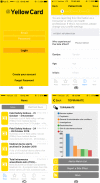Factors Influencing the Use of a Mobile App for Reporting Adverse Drug Reactions and Receiving Safety Information: A Qualitative Study
- PMID: 28035492
- PMCID: PMC5384960
- DOI: 10.1007/s40264-016-0494-x
Factors Influencing the Use of a Mobile App for Reporting Adverse Drug Reactions and Receiving Safety Information: A Qualitative Study
Abstract
Introduction: A mobile app may increase the reporting of adverse drug reactions (ADRs) and improve the communication of new drug safety information. Factors that influence the use of an app for such two-way risk communication need to be considered at the development stage.
Objective: Our aim was to reveal the factors that may influence healthcare professionals (HCPs) and patients to use an app for two-way risk communication.
Methods: Focus group discussions and face-to-face interviews were conducted in the Netherlands, Spain and the UK. Patients with type 2 diabetes mellitus, patients with a rare disease or their caregivers and adolescents with health conditions were eligible to participate. HCPs included pharmacists, paediatricians, general practitioners, internists, practice nurses and professionals caring for patients with a rare disease. Patients and HCPs were recruited through various channels. The recorded discussions and interviews were transcribed verbatim. The dataset was analysed using thematic analysis and arranged according to the Unified Theory of Acceptance and Use of Technology.
Results: Seven focus group discussions and 13 interviews were conducted. In total, 21 HCPs and 50 patients participated. Identified factors that may influence the use of the app were the type of feedback given on reported ADRs, how ADR reports are stored and the type of drug news. Also mentioned were other functions of the app, ease of use, type of language, the source of safety information provided through the app, security of the app, layout, the operating systems on which the app can be used and the costs.
Conclusions: Further research is needed to assess associations between user characteristics and the direction (positive or negative) of the factors potentially influencing app use.
Conflict of interest statement
Conflict of interest
Sieta T. de Vries, Lisa Wong, Alastair Sutcliffe, François Houÿez, Carmen Lasheras Ruiz, and Peter G.M. Mol declare that they have no conflicts of interest.
Ethical approval
All procedures performed in this study were carried out in accordance with the ethical standards of the institutional and/or national research committee and with the 1964 Helsinki declaration and its later amendments or comparable ethical standards. Ethical approval for this study was sought as determined by each country’s local ethics committee policy. In Spain, ethical approval was obtained from the Fundació Sant Joan de Déu. In the UK, ethical approval was obtained from the University College London. In the Netherlands, a waiver for full ethical approval was obtained from the University Medical Center Groningen (reference number M15.172178). Informed consent was obtained from all participants.
Funding
The Web-RADR project has received support from the Innovative Medicine Initiative Joint Undertaking (
Figures


References
MeSH terms
LinkOut - more resources
Full Text Sources
Other Literature Sources
Medical
Research Materials

